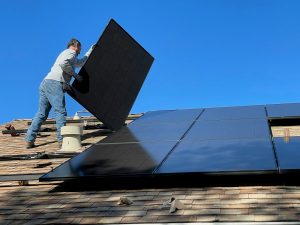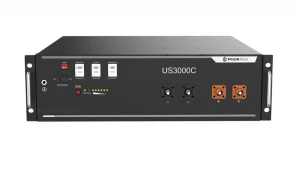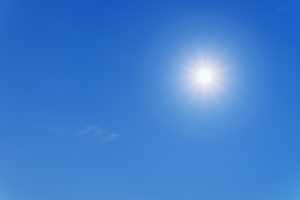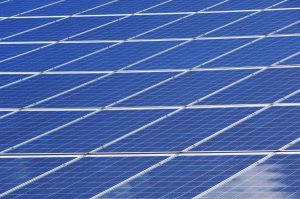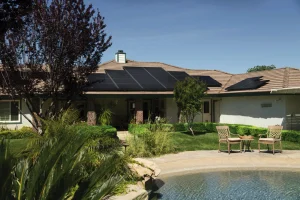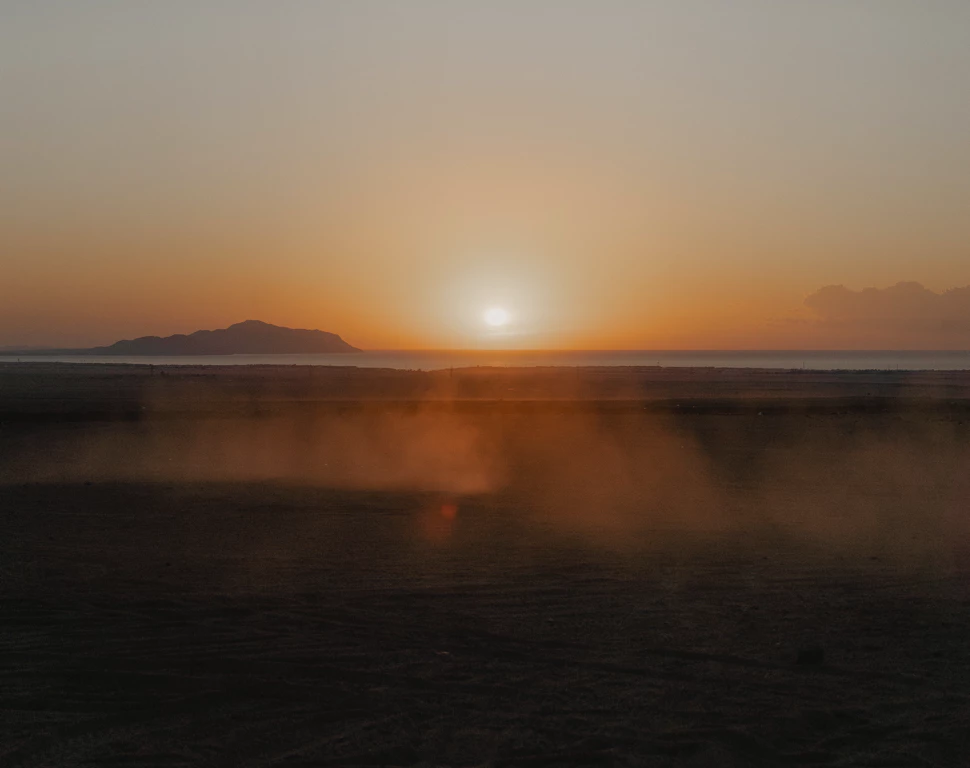
When reading about passive solar, the focus in many books is on solar heating. But many of us live in places where for much of the year it’s plenty hot already! So what about passive solar cooling?
For example where I live in Southern Spain, is very close to what is considered to be Europe’s only dessert. It can get extremely hot and humid in the summer months. The climate is most similar to Perth, Australia or Buenos Aires, Argentina.
For US readers, it’s sort of half way between Orlando FL and Los Angeles CA:
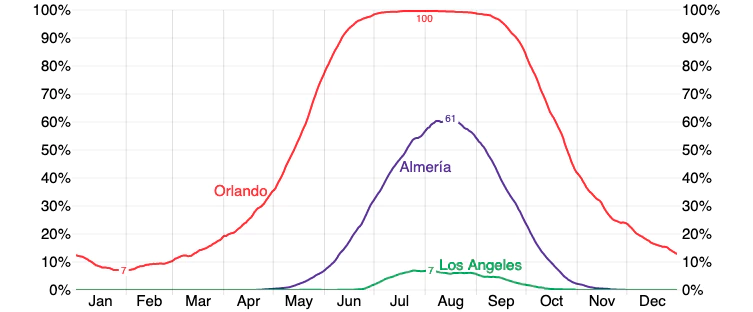
What's on this page?

What is a Passive Solar Heating and Cooling System?
Passive solar cooling is a set of design strategies used for creating new buildings, or adapting existing ones to maintain an optimal inside temperature each day and night by working with that natural changes in solar energy, winds, and outside temprature throughout days and across seasons.
These strategies in hot and humid climates often include: “minimizing heat gains with an adequate orientation, providing solar protection devices, minimizing conduction gains, providing thermal inertia, and allowing nocturnal heat loss” [1]
Passive solar cooling in hot and humid climates is part of an overal design strategy of working with the environment, which also means making use of solar heating to keep the house warm during winter and on colder nights.
Passive solar cooling can be used alongside active cooling systems such as air conditioning or heat pumps, to significantly reduce the energy useage of these systems. Or with the right design, passive cooling can achieve a comfortable temperature without any active cooling at all.
Passive Solar Cooling Techniques
Orientation
If you’re building a new home, then one major variable that you can control is the direction that it faces.
In the northern hemisphere, it’s been found that facing south is generally best. This gives you the most ability to control how much solar energy you use, which is also useful if you’re using passive solar heating and cooling alongside active solar to provide electricity for example.
“A building that faces South is generally easier to shade for summer coolness than one that faces East or West. In addition, using southern exposure for solar heat gain is recommended to reduce heating loads in the winter season. Southern exposure allows also us- ing shading strategies to reduce cooling loads caused by direct solar gain on south façades. They have to be equipped with shading devices like overhangs for summer time.”
Minimization of indoor temperatures and total solar insolation by optimizing the building orientation in hot climate – Article in Engineering Structures and Technologies [2]
Solar Chimney Passive Cooling
A solar chimney cools the interior of a house by creating airflow within the building. Exposed dark panels at the top allow air at the top to get heated when it’s sunny. Because hot air rises, this then creates a pressure difference which draws in cooler air from below.
In some designs, air ducts are built into below ground areas with large thermal mass, such as concrete blocks, water tanks, or natural wells. As the air flows out at the top of the solar chimney, air is drawn in via these cooler below ground areas, cooling the whole house.
Because this airflow increases when there is more sunlight, the whole system is naturally self regulating and can be truely passive. Automated vents and or fans can be added to enchance this natural effect.
Passive Solar Cooling Examples
Using Indoor Plants to Create a Microclimate
Some passive house designs incorporate plants to help cool and maintain a balanced temperature.
Rock Wall as Thermal Mass
How Does Humidity Effect Passive Solar Cooling?
The principles of passive solar design work in the same way in hot, humid climates as they do elsewhere. But one area where special attention should be given in humid areas is vapor control.
Reduced Heat Loss to the Atmosphere at Night
In hot dry climates, you can rely on cooling your home down at night through heat loss to the atmosphere and space. However in hot humid climates, the water vapour in the air acts as an insulation layer which prevents as much heat being radiated out and lost from the building.
So in hot humid climates, airflow through the building is one of the main strategies you’ll need to rely on to cool the property.
The amount of air changes per hour depends on the level of humidity in your location. Traditional building techniques, in the tropics for example, involve very porous walls and roofs to allow air to freely flow through the entire building.
In more modern buildings this can be achieved with solar chimneys plus assistated ventilation.
Insulation
Because passive house design typically involves higher levels of insulation that standard building techniques, there is a risk of trapping mouisture in the building. This can then lead to unpleasent problems including damp, mould, and rot.
Insulation is still important to have in hot humid climates. Instead of keeping heat in all the time, it’s purpose is:
- To keep heat out during hot times.
- To keep heat in on colder nights and during the winter.
When selecting insulation, it’s important to add positive vapor barriers. These prevent water getting inside of layers of insulation, which could rot or otherwise reduce the effectiveness of the insulation.
Airflow
Airflow is already an important aspect of passive solar cooling. In humid climates it becomes crucial to prevent water buildup inside.
It’s essential to provide good airflow throughout the whole home, but especially in bathrooms and kitchens, where ideally air should be drawn in from outside.
“This book recommends a whole house ventilation rate of 0.67 air changes per hour, which has been derived through experience as a healthy rate of air replenishment. Rates of less than 0.67 per hour will, in my opinion, endanger the health of the occupants. Further, inadequate ventilation will and can lead to other airborne problems, including possible mold buildup.”
Excerpt From: James Kachadorian. “The Passive Solar House”. Apple Books.
As we already mentioned when looking at solar chimneys, airflow routes can be designed so that incoming air is taken from the coolest point possible.
Passive solar home designs typically incorporate some kind of large thermal mass, for example a bonded concrete slab under the ground floor. This absorbs solar energy throughout the day and acts a heatsink.
Because this thermal mass is cooler than outside during the hottest parts of the day, air ducting can be designed to pass through it, cooling the air down as it passes through, as well as providing a constant flow of air without the need for fans (or at least minimal fans).
This all works together to prevent moisture buildup inside the property, whilst still alowing for optimium levels of insulation.
Conclusion
Passive solar cooling in hot humid climates is achievable using a variety of design strategies that can all work together to create a comfortable living environment, using very little or even zero electricity or other fuel to maintain.
Special attention needs to be given to vapour barriers and good airflow in humid climates. Equally important is ensuring that you have a well sized thermal mass, plus allowing the sun in just the right amount to not overheat your home.

